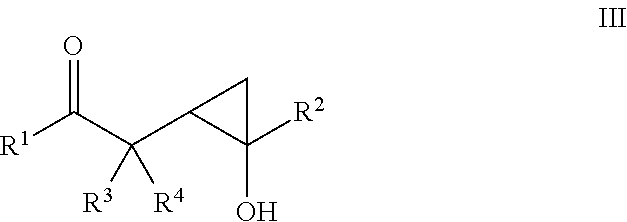beta- and gamma-diketones and gamma-hydroxyketones as WNT/beta-catenin signaling pathway activators
a signaling pathway and activator technology, applied in the field of activators, can solve the problems of increasing damaged or non-functioning hair follicles, increasing increasing hair loss, so as to increase cell or tissue regeneration, increase the successful activity of embryonic cells, and increase the effect of cell or tissue regeneration
- Summary
- Abstract
- Description
- Claims
- Application Information
AI Technical Summary
Benefits of technology
Problems solved by technology
Method used
Image
Examples
example 1
[0303]Preparation of compound (I) is depicted below in Scheme 5.
[0304]
Reagents and conditions: a) Ethanol, HCHO, HCl, refluxed, overnight; b) Dioxane, PhCHO, 3-Ethyl-5-(2-hydroxyethyl)-4-methylthiazolium bromide, 95° C., overnight.
Step a
[0305]A solution of 1-(2,3-dihydrobenzo[b][1,4]dioxin-6-yl)ethanone (XV) (11 mmol), dimethylamine hydrochloride (14 mmol), paraformaldehyde (16 mmol) and 12 N HCl (2 drops) in ethanol (5 mL) was refluxed overnight. The solution was cooled to room temperature and the ethanol was evaporated under vacuum. The residue was treated with ethyl acetate, heated slightly and sonicated to disperse into fine particles. The solids were filtered and dried at room temperature to produce 1-(2,3-dihydrobenzo[b][1,4]dioxin-6-yl)-3-(dimethylamino)propan-1-one (XVI) as a white solid, (82% yield), 1H NMR (CDCl3, 400 MHz): δ ppm 2.77 (s, 6H), 3.41 (m, 2H), 3.56 (m, 2H), 4.25 (m, 4H), 6.85 (m, 1H), 7.45 (m, 2H).
Step b
[0306]Triethylamine (3.61 mmol) and benzaldehyde (4.3 mm...
example 2
[0335]Preparation of compound (4) is depicted below in Scheme 6.
[0336]
Reagents and conditions: a) CH2Cl2, TFA, rt, overnight.
Step a
[0337]Neat TFA (0.5 mL) was added to a solution of 1-(2,3-dihydrobenzo[b][1,4]dioxin-6-yl)-4-(4-((2-methoxyethoxy)methoxy)phenyl)butane-1,4-dione 11 (0.35 mmol) in CH2Cl2 (5 mL) stirred at room temperature. The solution was further stirred overnight at room temperature. The volatiles were evaporated under vacuum. The residue was purified by flash chromatography over silica gel eluting with 1% methanol in CH2Cl2 to get 1-(2,3-dihydrobenzo[b][1,4]dioxin-6-yl)-4-(4-hydroxyphenyl)butane-1,4-dione 4 as an off white solid (21% yield). 1H NMR (CDCl3, 400 MHz): δ ppm 3.37 (m, 4H), 4.29 (m, 2H), 4.33 (m, 2H), 5.76 (s, 1H), 6.87 (d, J=8.8 Hz, 2H), 6.93 (m, 1H), 7.60 (m, 2H), 7.94 (d, J=8.8 Hz, 2H); ESIMS found C18H16O5 m / z 313 (M+H).
[0338]The following compounds was prepared in accordance with the procedure described in the above Example 2.
[0339]
[0340]1-(2,3-dihyd...
example 3
[0345]Preparation of compound (9) is depicted below in Scheme 7.
[0346]
Reagents and conditions: a) i) Et2NMgBLEt2O, Toluene, 0° C., 3 h ii) H2SO4, H2O, 0° C.-rt, iii) Et3N, rt.
Step a
[0347]In a dried 3 neck flask fitted with magnetic stirrer and condensor was placed metal magnesium (12 mmol) and ether (1.8 mL). Neat bromoethane (2.5 mmol) was added via syringe and the reaction was started immediately. A solution of bromoethane (10.5 mmol) in toluene (30 mL) was added to the solution slowly. After completion of the addition, the solution was stirred at room temperature for 30 min under nitrogen before adding neat diethylamine (24 mmol). The solution was further stirred at room temperature for 15 min. The solution was cooled to 0° C. and a mixture of 1-(pyridin-2-yl)ethanone (XVIII) (12 mmol) and 2-bromoisobutyrophenone (XVII) (13 mmol) was added to the solution. The solution was further stirred for 3 h at 0° C. under nitrogen. Aqueous 5% H2SO4 (20 mL) was added to the solution and the ...
PUM
| Property | Measurement | Unit |
|---|---|---|
| temperature | aaaaa | aaaaa |
| structure | aaaaa | aaaaa |
| morphology | aaaaa | aaaaa |
Abstract
Description
Claims
Application Information
 Login to View More
Login to View More - R&D
- Intellectual Property
- Life Sciences
- Materials
- Tech Scout
- Unparalleled Data Quality
- Higher Quality Content
- 60% Fewer Hallucinations
Browse by: Latest US Patents, China's latest patents, Technical Efficacy Thesaurus, Application Domain, Technology Topic, Popular Technical Reports.
© 2025 PatSnap. All rights reserved.Legal|Privacy policy|Modern Slavery Act Transparency Statement|Sitemap|About US| Contact US: help@patsnap.com



